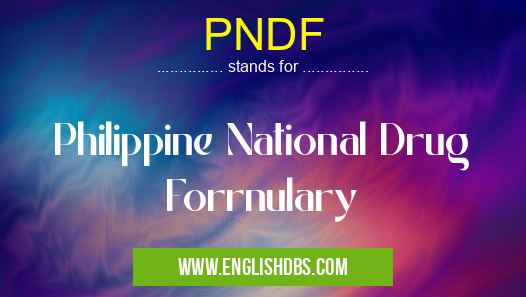What does PNDF mean in DRUGS
PNDF stands for the Philippine National Drug Formulary, which is a system of classification or categorization that differentiates legal drugs that are used in medicine from those that are not allowed for use. It is an important tool used by pharmaceutical companies, health care providers and institutions to ensure proper drug prescribing and utilization. The PNDF serves as a reference guide for Filipino healthcare professionals in prescribing, dispensing and administering drugs in accordance with the Filipinos’ legal and safety requirements established by the regulatory agencies of the country.

PNDF meaning in Drugs in Medical
PNDF mostly used in an acronym Drugs in Category Medical that means Philippine National Drug Forrnulary
Shorthand: PNDF,
Full Form: Philippine National Drug Forrnulary
For more information of "Philippine National Drug Forrnulary", see the section below.
What is PNDF
The Philippine National Drug Formulary (PNDF) is a comprehensive list of legal drugs approved by regulatory agencies for medical treatment within Philippines. It provides pharmaceutical companies, healthcare professionals and institutions with a reference guide on medications prescribed to patients based on their condition. Medications included on the PNDF are carefully selected based on their safety profiles, effectiveness, cost-effectiveness, ease of access, availability as well as compatibility with other treatments and medicines taken by the patient concurrently. At present, there are approximately 2,000 medications included in the PNDF which covers all major therapeutic areas such as cardiovascular disease prevention and management; diabetes; cancer; mental health; infectious diseases; gastroenterology; dermatology; ophthalmology just to name a few.
Benefits of Using PNDF
The most important benefit of using the Philippine National Drug Formulary (PNDF) is that it helps protect the safety of patients through promoting evidence-based prescribing practices. The formulary contains only those medications that have already been proven to be effective in treating specific conditions through clinical trials or real world experience. This ensures that patients get proper medication with minimal risks attached to it when it comes to potential side effects or interactions between different medications they may be taking at one time. Additionally, having fewer medications available also helps prevent over-prescription or irrational prescription which can lead to drug addiction or abuse. Furthermore, using only those medications approved by regulatory agencies reduces costs associated with additional research into new treatments since they have already been evaluated for their efficacy prior to release into market thus increasing cost efficiency for consumers
Essential Questions and Answers on Philippine National Drug Forrnulary in "MEDICAL»DRUGS"
What is the Philippine National Drug Formulary?
The Philippine National Drug Formulary (PNDF) is a list of medicines recommended by the Department of Health as essential for the health care needs of Filipino people. It contains medicines that are safe, effective, and provide good value for money. The PNDF serves as a guide for prescribers when selecting drugs to treat diseases and illnesses.
Who sets the standards for PNDF medicines?
The standards set by the Program Management Unit of the Department of Health ensure that all medicines included in the PNDF are safe, effective, and cost-efficient. All medicines evaluated by an independent expert panel and approved by the Secretary of Health are included in the PNDF.
How do I access PNDF information?
You can access information about medicines listed in the PNDF on the Department of Health website or through different mobile applications.
Are generic drugs allowed under PNDF?
Yes, generic drugs are allowed in the PNDF as long as they meet certain criteria such as safety, efficacy, quality control, and cost-effectiveness.
Is there any difference between branded drugs and generics listed under PNDF?
Both branded drugs and generics listed under PNDF must meet certain criteria to be included in it. However, generic drugs usually have lower costs than branded drugs so they may be more cost-effective for patients who do not have insurance coverage or financial resources to purchase brand-name medications.
Is there any specific guideline on how to use medications listed under PNFD?
Yes, each medication listed under PND includes dosing instructions along with its indications and warnings/precautions to make sure that they are used safely and effectively according to their approved indications. It is important to follow these guidelines carefully when using any medication listed under PHNDF.
How often does PHNDF update its list?
The PHNDF list is regularly reviewed and updated at least once every three years based on new evidence from research studies conducted both locally and abroad. Newer molecules or oral formulations that have been assessed to be safe, effective, cost-effective and appropriate will be added to replace those which no longer meet these criteria for inclusion into PHNDF after review by an independent expert panel approved by DOH Secretary.
What kind of strict monitoring is done on manufacturers producing medicines Under PHNDF?
Stringent quality control measures are required from drug manufacturers supplying medications for inclusion into PHNDF.These measures include compliance with Good Manufacturing Practices (GMP) requirements as specified by DOH,adherence to current regulations set forth by government agencies such as Bureau Of Food And Drugs (BFAD), Food And Drug Administration (FDA). Manufacturers also provided product samples evaluated according by GMP standards.
Final Words:
The Philippine National Drug Formulary (PNDF) serves as an important tool for healthcare professionals throughout Philippines when deciding which medications should be prescribed via prescription writing or used in combination therapy whenever necessary. It is a constantly evolving resource that helps promote evidence-based prescribing practices while ensuring patient safety through eliminating potentially harmful drugs from being used without undergoing evaluation first. With this helpful reference guide, pharmacists and doctors alike can provide Filipinos proper medication according to their condition while keeping them away from dangerous substances.
